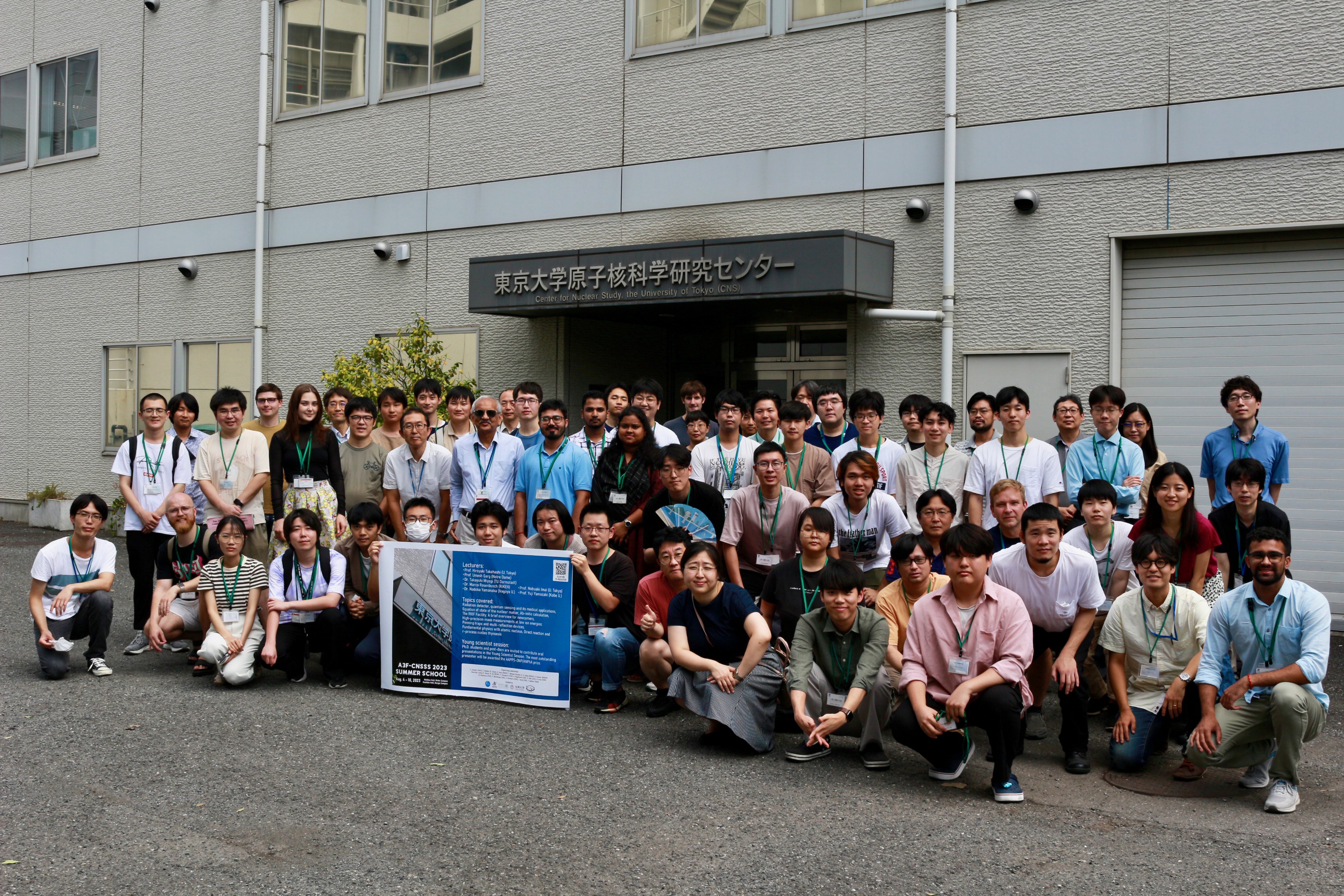A3F-CNS Summer School 2023
Dear Colleagues,
The 22th CNS International Summer School (A3F-CNSSS23), hosted by Center for Nuclear Study, the University of Tokyo, will be held for Aug.4 - 10, 2023. The school is co-hosted by JSPS A3-Foresight program, Super Heavy Element Center (RCSHE) and Center for Accelerator and Beam Applied Science (CABAS) of Kyushu University. Also, the school is supported by RIKEN Nishina Center and ANPhA.
The venue of the school is Nishina hall, RIKEN wako campus (4th, 7th, 8th, 9th, 10th/Aug) and Koshiba hall, Hongo campus, the University of Tokyo (5th/Aug). The school aims to foster the young generation of nuclear physicists. Before the covid pandemic, the participants of the school met together to discuss the lectures and beyond at the relaxed atmosphere after each school day, which enhanced the mutual understanding between participants.
Registration fee below for participants in-person is asked to pay in cash at the on-site registration.
- Staff scientists 3,000 JPY
- PD 2,000 JPY
- Others 1,000 JPY
The lecturers of the A3F-CNSSS23 are,
-
Prof. Hiroyuki Takahashi (University of Tokyo) "Radiation detector, quantum sensing and its medical applications"
-
Prof. Umesh Garg (University of Notre Dame) "Equation of state of the nuclear matter"
-
Dr. Takayuki Miyagi (TU Darmstadt) "Ab-initio calculation"
-
Dr. Marco Rosenbusch (RNC) "The RIBF Facility: A brief overview for newcomers", "High-precision mass measurements at low ion energies: Penning traps and multi-reflection devices"
-
Dr. Nodoka Yamanaka (Nagoya U.) "Fundamental physics with atomic nucleus"
-
Prof. Nobuaki Imai (CNS, Univ. of Tokyo) "Direct reaction and r-process nucleothynsesis"
-
Prof. Yuji Yamazaki (Kobe University) "Partonic structure of hadrons through DIS and physics at the EIC"
The registration is now open from Registration section of the web page.
As the past A3F-CNSSS, we will have young scientist sessions where the Ph.D students and Post-docs contribute to the oral presentation. From 2018 we select a few persons from the presentations as the winners of “CNSSS Young Scientist Awards”. The certificate will be given to the winners.
We plan to support the accommodation fee and travel expenses, although it is limited. The support will primarily come to those who perform an oral presentation. If you wish our support, please make a registration and submit your abstract from the web page of A3F-CNSSS23 by July 3rd (Mon).
We’re looking forward to seeing you at the school.
With best regards
A3F-CNSSS23 Local Organizing Committee

Ahmad Jafar Arifi
Akane Sakaue
Atsuya Kanai
Chandan Sarma
Chengxi Xu
Chihaya Fukushima
Chisato Ruike
Dae Ik Kim
Daiki Nishimura
DEEPAK PATEL
Dong Geon Kim
Donghyun Kwak
Eiji Ideguchi
Fulong Liu
Gen Takayama
Gwangjun Lee
Haozhao Liang
Hideki Ueno
Hidetoshi Yamaguchi
Hideyuki Sakai
Hikari Murakami
Hiroki Nagahama
Hiroyuki Takahashi
Hisato Tanaka
Hitoshi Baba
Hoi Hin Siu
Hyukjin Kwon
Jaewon Kim
Jenny Marie Wamstad Finsrud
Jiatai Li
Jinn Ming Yap
Jizhi Zhang
Jon Dahl
Jubin Park
Keisuke Nakamura
Keita Kamakura
Kentaro Yako
Kodai Okawa
Kohei Tanimoto
Kota Yanase
Kota Yoshinaga
Kotaro Suzuki
Linh Do
Marco Rosenbush
Masaaki Kimura
Mei AMITANI
Miki Fukutome
MINGLONG LI
Mirai Fukase
Mustafa YILMAZ
Nico Dicuonzo
Nobu Imai
Nodoka Yamanaka
Nori Kitamura
Noritaka Shimizu
Qian Zhang
Ranjan Sariyal
Reiko Kojima
Rin Yokoyama
Rozina Rahaman
Ryohsuke Yoshida
Ryotaro Kohara
Sangyeong Son
Seiya Hayakawa
Seonho Choi
Shin'ichiro Michimasa
Shinsuke OTA
Shintaro Nagase
Shoto Watanabe
Shujiro Shindo
Shutaro Hanai
Susumu Shimoura
Tadaaki Isobe
Taiki Sugiyama
Takayuki Miyagi
Taku Gunji
Tatsuhiro Hattori
Thomas Chillery
Tomohiro Uesaka
Tomoya Naito
Umesh Garg
Vincent PATTE
Vishal Malik
XiaoXu Dong
Yasuhiro Sakemi
Yixin Guo
Yosuke Yamamoto
Yuji Yamazaki
Yuki Kubota
Yuki Nakamura
Yuko Sekiguchi
Yusuke Tanaka
Yusuke Tsunoda
Yutaka Utsuno
Yuya Michimoto
